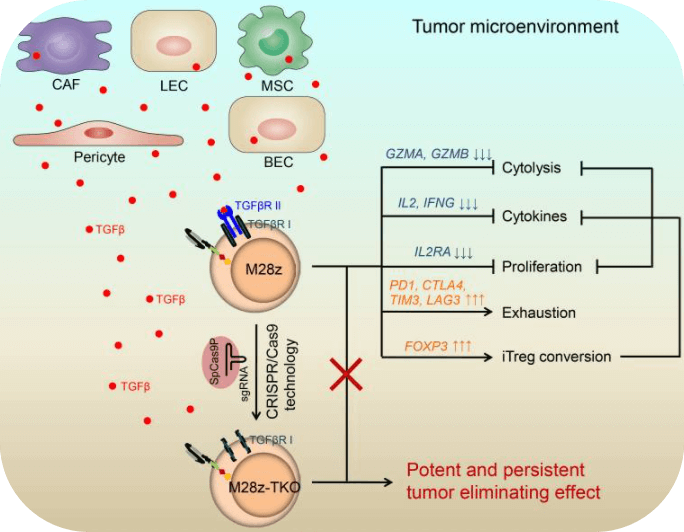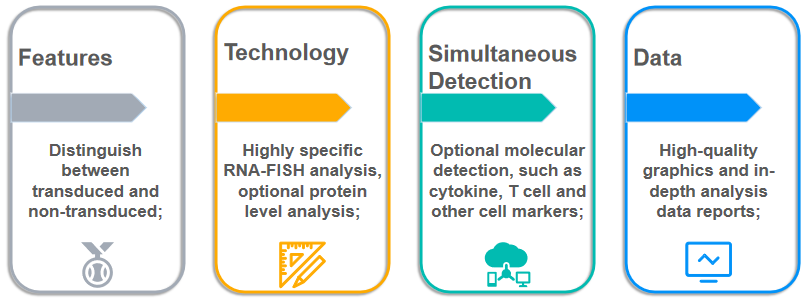Cell Therapy
Creative Bioarray provides a comprehensive in situ analysis solution for the characterization of engineered cells in solid tumors and many other diseases. This service utilizes molecular probes that highly target the untranslated regions or specific regulatory element regions in the mRNA of modified genes, and are characterized by high specificity. Our analysis service can help researchers analyze and characterize the engineered cells of FFPE samples, and combine IHC and other cytogenetic techniques to analyze the protein level expression of related molecules. This service enables visualization and quantitative analysis of CAR/TCR T cell infiltration and activation in tumor and non-tumor tissues.
Characterization of Engineered Cells in Cell Therapy
Cell therapy aims to repair the underlying mechanisms of disease occurrence and development. A variety of cell types can be used for this type of therapy, including stem cells, progenitor cells, or primary cells. It has been reported that the development of cell therapy methods includes cardiovascular, nervous system (Parkinson's disease, amyotrophic lateral sclerosis, stroke, spinal cord injury), autoimmune system (type 1 diabetes, multiple sclerosis, Crohn's disease) ), ophthalmology, kidney disease, liver and bone (osteoarthritis) diseases. In recent years, cell therapy has played an increasingly important role in the development of treatment methods for solid tumors. These methods include chimeric antigen receptor T cells (CAR-T) and T cell receptor T (TCR-T) cells as well as NK cell and macrophage therapies. The key to cell therapy lies in the development of engineered cells. In situ identification of engineered T cells is very important for understanding the location, persistence and phenotype of these cells after adoptive T cell therapy. Methods such as flow cytometry are only suitable for the characterization of engineered cells in fresh tissue or blood. For cell characterization in FFPE tissue samples, in situ hybridization has absolute advantages.
 Fig 1. Schematic diagram of the tumor microenvironment. (Tang N, et al. 2020)
Fig 1. Schematic diagram of the tumor microenvironment. (Tang N, et al. 2020)
In Situ Visual Analysis of Engineered Cells
The difficulty of in situ analysis of engineered cells such as CAR-T and TCR-T cells in FFPE samples is to distinguish them from non-transduced cells. This can be achieved by the design of highly specific probes. At present, some commercially available probes are designed for the visual analysis of engineered cells in cell therapy. They have usually located in the virus untranslated region (UTR) sequence probes and some specific regulatory elements present in the vector. For example, the woodchuck hepatitis post-transcriptional regulatory element (WPRE) element in the common lentiviral vector used for CAR-T. Our analysis services can be carried out based on these probes. Our molecular testing platform combines a variety of fluorescence microscopes, imaging equipment, and available excellent products, and has the ability to carry out highly specific RNA-FISH tests. In addition, our molecular platform also provides and simultaneously detects CAR/TCR vectors and cytokines, T cell markers, or other cell type markers molecular testing services. Our experts will tailor solutions for you to ensure comprehensive and efficient analysis and testing services to maximize the use of samples.
 Fig 2. Customization of in situ analysis solutions in cell therapy.
Fig 2. Customization of in situ analysis solutions in cell therapy.
If you are interested in our FISH service, please contact us for cooperation. We look forward to cooperating with you in the near future.
References
- Tang N, Cheng C, Zhang X, et al. TGF-β inhibition via CRISPR promotes the long-term efficacy of CAR T cells against solid tumors[J]. JCI insight, 2020, 5(4).
- Wright J H, Huang L Y, Weaver S, et al. Detection of engineered T cells in FFPE tissue by multiplex in situ hybridization and immunohistochemistry[J]. Journal of Immunological Methods, 2021, 492: 112955.
All products and services on this website are only suitable for non-medical purposes.


 Fig 1. Schematic diagram of the tumor microenvironment. (Tang N, et al. 2020)
Fig 1. Schematic diagram of the tumor microenvironment. (Tang N, et al. 2020) Fig 2. Customization of in situ analysis solutions in cell therapy.
Fig 2. Customization of in situ analysis solutions in cell therapy.


